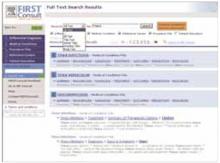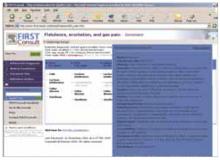Unquestionably, using electronic information sources at the bedside has the potential to improve the quality of clinical care. That potential is moving closer to realization with FIRSTConsult (formerly PDxMD)—a multifunction physician resource designed for point-of-care use. Its name reflects its connection with MDConsult, the well-known electronic collection of textbooks. Both are produced by Elsevier, whose imprints include Saunders, Mosby, and Churchill Livingstone, and whose publications include Dorland’s Medical Dictionary, Gray’s Anatomy, Harriet Lane Handbook, and The Lancet.
FIRSTConsult comes in 2 incarnations: a Web-based version and a handheld version. The latter is available both for the Palm and Pocket PC operating systems, with variants of about 2, 6, and 10 MB. We evaluated the Web version (hereafter “FC-Web”) and the 10-MB Palm OS version (“FC-Palm”). Descriptions of the smaller versions are available on the FIRSTConsult web site.
As long as a user has access to a high-speed Internet connection, we give FC-Web a “thumbs up” as a rapid, real-time, point-of-care resource. FC-Palm is a portable mini-version of the Medical Conditions and Differential Diagnosis sections of FC-Web. In this article, we detail the advantages and disadvantages of both products.
FC-Web
FC-Web’s opening screen (Figure 1) lists its 5 major components, along with a search box that scans all components simultaneously. Searching “tinea,” for example, produces 529 retrievals (Figure 2). Users may modify search parameters with check boxes and drop-down lists.
FIGURE 1
FIRSTConsult’s opening screen
FIGURE 2
Typical FIRSTConsult search screen
Information retrieval with FC-Web
Clicking one of FC-Web’s components opens a search function or an alphabetic list to locate the desired monograph (Figure 3).
Improved search function. The search function for FC-Web is profoundly improved from that of its predecessor, PDxMD. The search retrievals include section titles (eg, Summary, Background, Diagnosis; see Figure 2), allowing users to link directly to the subject of interest. There is extensive mapping by synonyms, such that “AAA” finds “abdominal aortic aneurysm” and “TIA” finds “transient ischemic attack.” The search feature does not take wild cards or partial words and is intolerant to misspelling (eg, “vonWillebrand” vs “von Willebrand”).
Useful hyperlinks. FC-Web has extensive hyperlinks within its monographs and sections and to other components of the program, and they are among the most useful and logical links these reviewers have seen. Additionally, the program contains hyperlinks to MDConsult (for MDConsult subscribers only) and to excellent external resources, such as consensus statements. Where applicable, levels of evidence and references are cited.
Drawbacks. Regarding speed, we believe FC-Web requires high-speed access for true point-of-care use. FC-Web limits users to 1 open window—even hyperlinks to external sources cannot be opened in new windows.
FIGURE 3
Medical Conditions
Differential diagnosis section
This section provides differential diagnoses—broken into categories by patient age—for about 350 symptoms and signs. The search feature maps to close entries. For example, clicking on Differential Diagnosis and entering the search term “burping,” FC-Web maps to flatulence, eructation, and gas pain. Interestingly, some of the more common causes we see for burping in practice—anxiety/aerophagia, ingestion of dissolved gas (carbonated beverages), and ingestion of bicarbonate—do not appear.
For any condition found on the Differential Diagnosis monograph summary screens, a click pulls up a mini-summary of the illness, nicely leveraging the electronic environment (Figure 4). Users can click through to corresponding FC-Web disease monographs (if available) or to the topic in MDConsult (separate subscription required).
Limitations. Unlike differential diagnosis engines such as DXplain (available at www.lcs.mgh.harvard.edu/dxplain.htm), the Differential Diagnosis section of FC-Web does not allow users to enter sets of data (eg, age; sex; findings) to produce a list of possible diagnoses. Surprisingly, FC-web’s Differential section does not include “hyponatremia” (or “SIADH”), although it contains such things as “hypernasality” and “hypogeusia.”
FIGURE 4
Summary of a Differential Diagnosis





